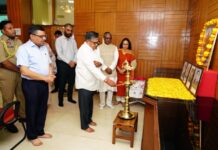BLUEPRINT FOR CHANGE: BIS SPECIAL PUBLICATION SP:73 FOR A SAFER, SMARTER BUILT ENVIRONMENT
Breaking Ground: India’s New Building Code Set to Redefine Urban Landscape
In a groundbreaking development, the Bureau of Indian Standards unveiled the ‘Standardized Development and Building Regulations, 2023,’ encapsulated in Special Publication SP 73: 2023. The release ceremony, officiated by Shri Ashwini Kumar Choubey, Hon’ble Minister of State for Consumer Affairs, Food & Public Distribution, and Ministry of Environment, Forest and Climate Change, took place on January 6, 2024, coinciding with the Foundation Day celebrations of BIS.
This Special Publication mark a significant stride towards revolutionizing India’s built environment. Aligned with the National Building Code of India 2016 (NBC 2016) and drawing inspiration from global best practices, these regulations set forth a comprehensive framework aimed at ensuring safety, accessibility, and sustainability in construction. The document emerges as a beacon of uniformity, designed to streamline structuring and detailing of the development and building regulations of the States/UTs, as well as to streamline the building regulatory system across the nation while accommodating the specific needs of individual states, union territories (UTs), and local bodies.
The genesis of these Standardized Regulations lies in a meticulous project aimed at promoting the adoption of NBC 2016 nationwide. The initiative involved an exhaustive study of existing rules and regulations across the country, coupled with a comparative analysis of international best practices governing land and building development. Workshops and discussions held nationwide gathered input and feedback, all of which were successfully integrated into the final document.
What sets this document apart is its user-friendly approach. Crafted in plain language for clarity, the regulations eliminate ambiguity, ensuring a seamless adoption process. The comprehensive content, complemented by various forms and checklists, facilitates easy understanding. Visual aids, including illustrations and flowcharts, enhance comprehension, while explanatory notes underscore key aspects. Standardized numbering further eases translation into different languages.
Moreover, the forward-looking nature of this document is evident in its incorporation of new age ideas and concepts. Addressing elements such as EV Charging Stations, Wind Electricity Generators, Transferable Development Rights, Transit Oriented Development, High Security Areas, Retirement Homes, the regulations embrace innovation.
Key stakeholders who benefit from document :
The key beneficiaries of this document are the following:
- Ministry of Housing and Urban Affairs (MoHUA) and Town and Country Planning Organization (TCPO) under MoHUA;
- State and Union Territory Governments;
- Local Bodies (LBs), both urban and rural;
- Development Authorities (DAs);
- Cantonment Boards and Port Trusts;
- Zila and Gram Panchayats; and
- Other organizations involved in the development of built environment.
Accessible for all
To ensure that the document is easy to understand, adopt/adapt, implement and comply with, a number of measures have been undertaken while drafting it, some of which are given below:
- The structuring of the chapters and the document as a whole has been done in the order of the development process for the most part. This makes the document a cogent continuous volume.
- Explanatory notes have been outlined at the beginning of each chapter to brief the users about the contents therein, in the form of major highlights.
- To enable easy navigation through the document and easy identification of the regulations, the items, clauses, sub-clauses, tables, figures, annexes, etc have been duly numbered in a standardized manner.
- The regulations have been supported with figures and flowcharts wherever necessary, to enhance their interpretation visually.
- The regulations are so written as to ensure that there is no room for multiple interpretations, and effort has been made to frame the regulations in a manner that it is unambiguous.
- Wherever there is a possibility of an ambiguity arising in the interpretation of a clause or an exception occurring to the rule, notes have been inserted to clarify the same.
- Key provisions of NBC 2016 related to safety, sustainability and accessibility have been specifically incorporated for ensuring ease of implementation.
- Latest developments and advancements in the field of land development and building construction have also been addressed considering available guidelines and regulations.
The document envisions a future where regulatory bodies operate more transparently and efficiently, facilitating easy access to services provided by registered building professionals. The document proposes ways in which regulatory bodies can harness common rules and regulations to collect verifiable data, leveraging Information Technology for efficient service delivery. As a progressive blueprint for the construction industry, these regulations anticipate a positive impact on the ease of doing business, laying the groundwork for a resilient and sustainable built environment in India.











